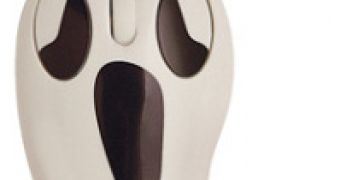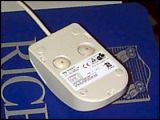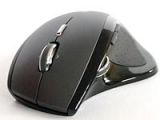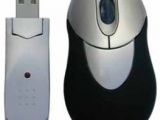Mice are cute little rodents (sometimes nasty) that like to hang around inhabited places. Some special ones even like to help you interact with your PC's graphical user interface (GUI). These are the so called computer "mice", a rather underestimated device when it comes to technological progresses. They really deserve an article and why not today's article?
The little cyber-rodent When related to IT&C, a mouse is nothing more than a handheld pointing device. It is usually designed to be controlled with one hand and to detect movement relative to its two-dimensional supporting surface. In addition, it also features buttons and/or other devices, such as "wheels", which enable users to interact more efficiently with their computer programs. These extra buttons or features can add more control or dimensional input.
Although it appears to be a puny and insignificant device (relatively cheap too, when compared with other PC components), this little fella comes in handy most of the times you sit around the PC. You reach out for your mouse whenever you want to move your cursor (the arrow on the OS screen) or activate something. The "rodent" senses your hand motions and your clicks or wheel-movements and sends them to the motherboard, and thus, the OS and you interact at will.
Prehistoric specimens Douglas Engelbart of the Stanford Research Institute is acknowledged to be the inventor of the electronic mouse. It was in 1963 that Engelbart's team called the first pointing device a "bug" - one of several experimental pointing-devices developed for Engelbart's oN-Line System (NLS).
The first mouse, a bulky device, used two gear-wheels perpendicular to each other. The rotation of each wheel translated into motion along one axis. Engelbart managed to obtain patent US3541541 on November 17, 1970 for what was known as an "X-Y Position Indicator for a Display System". At the time, Engelbart envisaged that users would hold the mouse continuously in one hand and type on a mini-keyboard with five keys with the other.
Bill English thought of another design and came up with the so-called "ball mouse" in the early 1970s while working for Xerox PARC. The ball-mouse replaced the rudimentary external wheels with a single ball that could rotate in any direction. In addition, there were perpendicular chopper wheels housed inside the mouse's body, which chopped beams of light on the way to light sensors, making the detection of the ball's movements possible. This mouse design resembled an inverted trackball and it was largely adopted in the 1980s and 1990s.
Light pens were used on a variety of machines as a pointing device for many years, while graphics tablets or joysticks accompanied many computing devices in the 1970s. None of these really proved to be the pointing device of choice, however.
Honeywell produced a rather short-lived type of mechanical mouse. Instead of a ball, it had two plastic "feet" on the bottom which sensed movement.
Modern computer owe it to the ?cole polytechnique f?d?rale de Lausanne(EPFL) under the inspiration of Professor Jean-Daniel Nicoud and at the hands of engineer and watchmaker Andr? Guignard from Switzerland. The Logitech Company also derived from EPFL and launched the first popular breed of electronic mice.
The major movement-translation techniques employed in computer mice involve optical, mechanical and inertial sensors. In addition, mice may come in one, two or three main button configurations. Scroll and tilt wheels (for fast page scrolling), shortcut buttons and other ergonomic-friendly features might be included in the mouse. Keep in mind that you can connect the mouse to your computer via the good ol' PS/2 connector or via the newer USB one.
This mouse has "balls" The old-fashioned ball mouse was popular in the 1980s and 1990s, but it had to make way for the optical wave eventually.
Let's take a look inside a ball mouse (be sure to check out the image provided)
- A ball inside the mouse touches the desktop and rolls when the mouse moves. (1) - Two rollers inside the mouse touch the ball (2). One of the rollers is oriented so that it detects motion in the X direction, and the other is oriented 90 degrees to the first roller so it detects motion in the Y direction. When the ball rotates, one or both of these rollers rotate as well. - The rollers each connect to a shaft, and the shaft spins a disk with holes in it (3). When a roller rolls, its shaft and disk spin. A typical optical encoding disk has around 36 holes around its outer edge. - On either side of the disk there is an infrared LED and an infrared sensor (4). The holes in the disk break the beam of light coming from the LED so that the infrared sensor sees pulses of light. The rate of the pulsing is directly related to the speed of the mouse and the distance it travels. - An on-board processor chip (5) reads the pulses from the infrared sensors and turns them into binary data that the computer can understand. The chip sends the binary data to the computer through the mouse's cord.
This is how a ball mouse detects movement, but there are also hardware pieces that detect button activation and send the appropriate signals to the computer.
An optics graduate An optical mouse uses a light-emitting diode and photo-diodes to detect movement relative to the underlying surface.
The first optical mice were designed in the early 1980s and followed 2 directions:
1. Some, such as those invented by Steve Kirsch of Mouse Systems Corporation, used an infrared LED and a four-quadrant infrared sensor to detect grid lines printed on a special metallic surface with infrared absorbing ink. This type of mouse featured a sort of CPU, which calculated the speed and the direction over the grid via predictive algorithms. 2. Others, invented by Richard F. Lyon and sold by Xerox, used a 16-pixel visible-light image sensor with integrated motion detection on the same chip and tracked the motion of light dots in a dark field of a printed paper or similar mouse pad.
However, optical mice were introduced on the market as late as 1999. The actual optical mouse uses a tiny camera to take thousands of pictures every second. Present day optical mice are more efficient, too. They are able to work on almost any surface without a mouse pad, using a red light-emitting diode (LED) that bounces light off that surface onto a complimentary metal-oxide semiconductor (CMOS) sensor.
Here's a brief look at how optical mice work:
* The CMOS sensor sends each image to a digital signal processor (DSP) for analysis. * The DSP detects patterns in the images and examines how the patterns have moved since the previous image. * Based on the change in patterns over a sequence of images, the DSP determines how far the mouse has moved and sends the corresponding coordinates to the computer. * The computer moves the cursor on the screen based on the coordinates received from the mouse. This happens hundreds of times each second, making the cursor appear to move very smoothly.
As optical mice are considered an improvement over track-ball mice, here are some of the benefits:
* No moving parts means less wear and a lower chance of failure. * Little to no dirt can get inside the mouse and interfere with the tracking sensors. * Increased tracking resolution means a smoother and faster response. * The mouse-pad becomes redundant in most of the cases.
Moreover, you can find optomechanical mice which detect movements of the ball optically, giving the precision of optical without the surface compatibility problems, whereas optical mice detect movement relative to the surface by examining the light reflected off it.
Jedi mouse, may the Force be with you... always As early as 1998, Sun Microsystems provided a laser mouse with their Sun SPARC Station servers and workstations, but the technology was quite expensive back then. It was in 2004 that Logitech, along with Agilent Technologies, introduced an affordable laser mouse model - the MX 1000. This mouse uses a small infrared laser instead of an LED, which according to the companies can increase the resolution of the image taken by the mouse, leading to around 20X more sensitivity to the surface features used for navigation compared to conventional optical mice, via interference effects.
Gamers have complained that the MX 1000 does not respond immediately to movement after it is picked up, moved, and then put down on the mouse pad. Newer revisions of the mouse do not suffer from this problem, which results from a power-saving feature (almost all optical mice, laser or LED based, also implement this power-saving feature, except those intended for use in gaming, where a millisecond of delay becomes significant). Engineers designed the laser mouse - as a wireless mouse - to save as much power as possible. In order to do this, the mouse blinks the laser when in standby mode (8 seconds after the last motion). This function also increases the laser life.
Headshot! Amongst the factors that affect the accuracy of optical and laser mice, the most important seems to be resolution. The resolution is the number of pixels per inch that the optical sensor and focusing lens "see" when you move the mouse. Resolution is expressed as dots per inch (dpi). The higher the resolution, the more sensitive the mouse is and the less you need to move it to obtain a response.
Most common optical mice feature resolutions between 400 and 800 dpi. However, specially designed mice for computer games can offer as much as 1600 dpi or even 2000 dpi. Some gaming mice also allow you to decrease the dpi on the fly to make the mouse less sensitive in situations when you need to make smaller, slower movements. For example, you may need a higher resolution in strategy games, while shooters might need a lower one for improved accuracy (don't you just love headshots?).
Other factors that influence the quality of a present-day mouse include:
* Size of the optical sensor - larger is generally better. Sizes range from 16 x 16 pixels to 30 x 30 pixels. * Refresh rate - shows how often the sensor samples images as you move the mouse. Faster is generally better. Rates range from 1500 to 6000 samples per second. * Image processing rate - is a combination of the size of the optical sensor and the refresh rate. As usual, faster is better and rates range from 0.486 to 5.8 megapixels per second. * Maximum speed - is the maximum speed at which you can move the mouse and still obtain accurate tracking. Faster is better and rates range from 16 to 40 inches per second.
Yo, where's my tail? If you are sick and tired of that sometimes annoying mouse cord, you might want to try the wireless technology. Most wireless mice use radio frequency (RF) technology to communicate information to your computer. Being radio-based, RF devices require two main components - a transmitter and a receiver. An RF mouse works something like this:
* The transmitter is housed in the mouse. It sends an electromagnetic (radio) signal that encodes the information about the movements of the mouse and the buttons you click. * The receiver, which is connected to your computer, accepts the signal, decodes it and passes it on to the mouse driver software and your computer's operating system. * The receiver can be a separate device that plugs into your computer, a special card that you place in an expansion slot, or a built-in component.
Apart from the RF type, the receiver may alternatively use Bluetooth technology. The RF receiver usually connects via PS/2, while Bluetooth receivers connect via USB.
Historically, corded mice have been more responsive than wireless mice. This fact is already changing, however, with the advent of improvements in wireless technologies and optical sensors.
This would be all for our brief look at computer mice. The next article is going to focus on the computer keyboard. And Merry Christmas to y'all!

 14 DAY TRIAL //
14 DAY TRIAL // 







